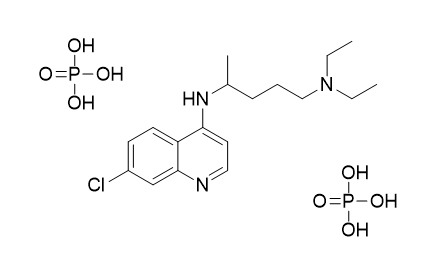Chloroquine diphosphate
Chloroquine diphosphate is a 4-aminoquinoline anti-malarial and anti-rheumatoid agent, also acting as an ATM activator. Chloroquine is also an inhibitor of toll-like receptors (TLRs).
Inquire / Order:
manager@chemfaces.com
Technical Inquiries:
service@chemfaces.com
Tel:
+86-27-84237783
Fax:
+86-27-84254680
Address:
1 Building, No. 83, CheCheng Rd., Wuhan Economic and Technological Development Zone, Wuhan, Hubei 430056, PRC
Providing storage is as stated on the product vial and the vial is kept tightly sealed, the product can be stored for up to
24 months(2-8C).
Wherever possible, you should prepare and use solutions on the same day. However, if you need to make up stock solutions in advance, we recommend that you store the solution as aliquots in tightly sealed vials at -20C. Generally, these will be useable for up to two weeks. Before use, and prior to opening the vial we recommend that you allow your product to equilibrate to room temperature for at least 1 hour.
Need more advice on solubility, usage and handling? Please email to: service@chemfaces.com
The packaging of the product may have turned upside down during transportation, resulting in the natural compounds adhering to the neck or cap of the vial. take the vial out of its packaging and gently shake to let the compounds fall to the bottom of the vial. for liquid products, centrifuge at 200-500 RPM to gather the liquid at the bottom of the vial. try to avoid loss or contamination during handling.
Int J Mol Sci.2022, 23(5):2796.
Molecules.2023, 28(10):4062.
Nutr Metab (Lond).2019, 16:31
Int J Biol Macromol.2020, 169:342-351
Molecules.2019, 24(9):E1719
South African Journal of Botany2024, 168:209-220.
Molecules.2024, 29(5):1050.
Molecules.2020, 25(18),4089.
Asian Pac J Cancer Prev. 2020, 21(4):935-941.
Food Sci Biotechnol.2023, 32(9):1215-1223.
Related and Featured Products
Pharmacol Ther,Feb-Mar 1993;57(2-3):203-35.
Chloroquine: mechanism of drug action and resistance in Plasmodium falciparum.[Pubmed:
8361993]
Quinoline-containing drugs such as chloroquine and quinine have had a long and successful history in antimalarial chemotherapy. Although these drugs are known to accumulate by a weak base mechanism in the acidic food vacuoles of intraerythrocytic trophozoites and thereby prevent hemoglobin degradation from occurring in that organelle, the mechanism by which their selective toxicity for lysosomes of malaria trophozoites is achieved has been subject to much discussion and argument.
METHODS AND RESULTS:
In this review the recent discovery that chloroquine and related quinolines inhibit the novel heme polymerase enzyme that is also present in the trophozoite food vacuole is introduced. The proposal that this inhibition of heme polymerase can explain the specific toxicity of these drugs for the intraerythrocytic malaria parasite is then developed by showing that it is consistent with much of the disparate information currently available. The clinical usefulness of chloroquine, and in some recent cases of quinine as well, has been much reduced by the evolution and spread of chloroquine resistant malaria parasites. The mechanism of resistance involves a reduced accumulation of the drug, although again the mechanism involved is controversial.
CONCLUSIONS:
Possible explanations include an energy-dependent efflux of preaccumulated drug via an unidentified transmembrane protein pump, or an increase in vacuolar pH such that the proton gradient responsible for drug concentration is reduced. New data are also presented which show that heme polymerase isolated from chloroquine resistant trophozoites retains full sensitivity to drug inhibition, consistent with the observation that resistance involves a reduced accumulation of the drug at the (still vulnerable) target site.
The significance of this result is discussed in relation to developing new strategies to overcome the problem presented by chloroquine resistant malaria parasites.
Lancet Infect Dis,2003 Nov;3(11):722-7.
Effects of chloroquine on viral infections: an old drug against today's diseases?[Pubmed:
14592603]
Chloroquine is a 9-aminoquinoline known since 1934. Apart from its well-known antimalarial effects, the drug has interesting biochemical properties that might be applied against some viral infections.
METHODS AND RESULTS:
Chloroquine exerts direct antiviral effects, inhibiting pH-dependent steps of the replication of several viruses including members of the flaviviruses, retroviruses, and coronaviruses. Its best-studied effects are those against HIV replication, which are being tested in clinical trials. Moreover, chloroquine has immunomodulatory effects, suppressing the production/release of tumour necrosis factor alpha and interleukin 6, which mediate the inflammatory complications of several viral diseases. We review the available information on the effects of chloroquine on viral infections, raising the question of whether this old drug may experience a revival in the clinical management of viral diseases such as AIDS and severe acute respiratory syndrome, which afflict mankind in the era of globalisation.
Curr Opin Microbiol,2000 Aug;3(4):349-53.
Chloroquine and the fungal phagosome.[Pubmed:
10972492]
METHODS AND RESULTS:
The antimalarial drug chloroquine accumulates inside the macrophage phagolysosome by ion trapping where it exerts potent antifungal activity against Histoplasma capsulatum and Cryptococcus neoformans by distinct mechanisms. Chloroquine inhibits growth of H. capsulatum by pH-dependent iron deprivation, whereas it is directly toxic to C. neoformans. Clearly, clinical studies are required to document the potential therapeutic efficacy of chloroquine or related congeners as adjuvant therapy in fungal disease. Moreover, the diversity of pathogenic microorganisms inhibited and/or killed by chloroquine makes this drug an attractive candidate for prophylactic therapy.



